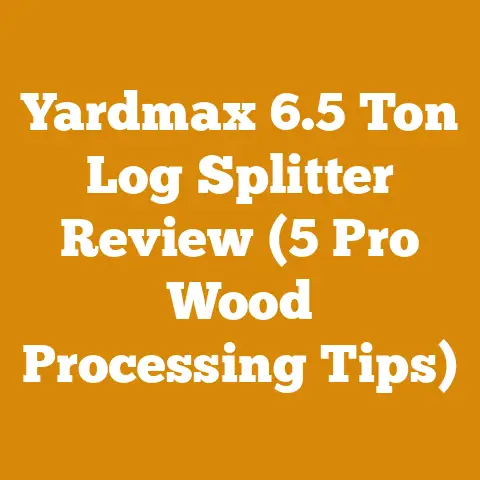Drying Board Tips for Firewood (7 Pro Hacks to Speed Seasoning)
A stack of wood that rots before it’s properly seasoned is a wasted investment, both in terms of time and money. That’s why understanding the best drying methods is crucial, especially when you’re aiming for efficiency and cost-effectiveness. In this article, I’ll share my insights and experiences, along with data-driven strategies to help you master the art of firewood seasoning, minimizing costs, and maximizing the quality of your burn.
Introduction: Why Drying Boards Matter
As someone who has spent a considerable amount of time splitting, stacking, and seasoning firewood, I can tell you that proper drying is the difference between a roaring fire and a smoky, frustrating one. Drying boards, also known as pallets or skids, play a vital role in this process. They elevate the firewood off the ground, promoting airflow and preventing moisture from wicking up from the earth. This simple step can significantly speed up the seasoning process and reduce the risk of rot and mold.
1. The Science of Seasoning: Understanding Moisture Content and Drying Time
Before diving into the hacks, let’s understand the science behind seasoning. Freshly cut wood can have a moisture content (MC) of 50% or higher. For optimal burning, you want the MC to be below 20%. Seasoning is the process of reducing this moisture content through natural air drying.
- Ideal Moisture Content: Below 20% for efficient burning.
- Freshly Cut Wood MC: Typically 50% or higher.
- Seasoning Time: Varies depending on wood species, climate, and drying method.
Data Point: According to the U.S. Department of Energy, properly seasoned firewood produces up to 25% more heat than green wood and reduces creosote buildup in your chimney.
My Experience: I once made the mistake of burning unseasoned oak. The fire was sluggish, produced a lot of smoke, and left a thick layer of creosote in my chimney. It was a lesson learned the hard way.
2. Hack #1: Choosing the Right Drying Board Material: A Cost-Benefit Analysis
Not all drying boards are created equal. The material you choose can impact both the effectiveness of the drying process and the longevity of the board itself.
- Wood Pallets: Readily available and often free, wood pallets are a popular choice. However, they can be prone to rot and may contain nails or staples.
- Plastic Pallets: More durable and resistant to moisture, plastic pallets are a longer-term investment. They also tend to be easier to clean.
- Concrete Blocks: Extremely durable and provide excellent elevation, concrete blocks are a good option for permanent firewood stacks.
- Homemade Wooden Frames: Building your own frame allows for customization but requires time and materials.
Cost Breakdown:
| Material | Initial Cost | Lifespan | Pros | Cons |
|---|---|---|---|---|
| Wood Pallets | $0 – $10 | 1-3 years | Inexpensive, readily available | Prone to rot, may contain nails, not very durable |
| Plastic Pallets | $20 – $50 | 5+ years | Durable, moisture-resistant, easy to clean | More expensive upfront |
| Concrete Blocks | $5 – $10 per block | 10+ years | Extremely durable, excellent elevation | Heavy, less portable |
| Homemade Frame | $10 – $30 | 3-5 years | Customizable, can be built to specific dimensions | Requires time and skill to build, can be prone to rot depending on wood type |
Personal Insight: I’ve used a combination of wood and plastic pallets. I find that plastic pallets are worth the investment for the base layer, as they prevent moisture from wicking up from the ground.
3. Hack #2: Optimizing Airflow: The Importance of Spacing and Orientation
Airflow is the key to efficient seasoning. Without proper airflow, the moisture will remain trapped in the wood, prolonging the drying process and increasing the risk of rot.
- Spacing Between Boards: Ensure at least 4-6 inches of space between drying boards to allow for adequate airflow.
- Stacking Orientation: Align the firewood perpendicular to the prevailing wind direction to maximize exposure to air currents.
- Elevating the Stack: Aim for at least 12 inches of elevation off the ground.
- Covering the Top: Cover the top of the stack with a tarp to protect it from rain and snow, but leave the sides open for ventilation.
Data Point: Studies have shown that proper airflow can reduce seasoning time by up to 50%.
My Experience: I once stacked firewood too tightly, and it took almost twice as long to season. Now, I make sure to leave plenty of space between rows and stacks.
4. Hack #3: Wood Species Matters: Understanding Drying Rates and Cost Implications
Different wood species have different drying rates and burning characteristics. Understanding these differences can help you choose the right wood for your needs and optimize your seasoning process.
- Softwoods (Pine, Fir): Dry quickly (6-9 months), but burn faster and produce less heat.
- Hardwoods (Oak, Maple, Ash): Dry slower (12-24 months), but burn longer and produce more heat.
- Density and Porosity: Denser woods like oak require longer seasoning times due to their lower porosity.
Cost Implications:
- Softwoods: Lower initial cost, but higher consumption rate.
- Hardwoods: Higher initial cost, but lower consumption rate and higher heat output.
Data Point: A cord of oak can produce up to 30% more heat than a cord of pine.
Personal Insight: I prefer to burn a mix of hardwoods and softwoods. I use softwoods for quick fires and hardwoods for sustained heat. I typically budget more for hardwoods because of their higher BTU output.
5. Hack #4: DIY Drying Board Construction: Saving Money and Customizing Your Setup
Building your own drying boards can save you money and allow you to customize your setup to fit your specific needs.
- Materials: Use pressure-treated lumber for durability and resistance to rot.
- Design: Keep the design simple and functional. A basic frame with slats is sufficient.
- Dimensions: Customize the dimensions to fit your firewood stack and available space.
- Fasteners: Use screws instead of nails for added strength and durability.
Cost Comparison:
| Option | Material Cost | Labor Cost | Total Cost |
|---|---|---|---|
| Pre-built Pallets | $0 – $50 per pallet | $0 | $0 – $50 |
| DIY Drying Boards | $10 – $30 | $0 – $20 (DIY) | $10 – $50 |
Step-by-Step Guide to Building a DIY Drying Board:
- Gather Materials: Pressure-treated lumber, screws, drill, saw, measuring tape.
- Cut Lumber: Cut the lumber to the desired dimensions.
- Assemble Frame: Assemble the frame using screws.
- Add Slats: Add slats to the frame, spacing them evenly apart.
- Sand Edges: Sand any rough edges to prevent splinters.
My Project: I built a set of custom drying boards using reclaimed lumber. It saved me money and allowed me to create a setup that perfectly fit my firewood storage area.
6. Hack #5: Moisture Meter Magic: Monitoring Drying Progress and Avoiding Costly Mistakes
A moisture meter is an invaluable tool for monitoring the drying progress of your firewood. It allows you to accurately measure the moisture content and determine when the wood is ready to burn.
- Types of Moisture Meters: Pin-type and pinless meters are available. Pin-type meters are more accurate but can damage the wood.
- Target Moisture Content: Aim for a moisture content below 20%.
- Testing Procedure: Test multiple pieces of wood in different locations to get an accurate reading.
- Record Keeping: Keep a record of your moisture readings to track the drying progress over time.
Cost of Moisture Meters:
- Pin-type Meters: $20 – $50
- Pinless Meters: $50 – $200
Data Point: Using a moisture meter can prevent you from burning unseasoned wood, which can damage your chimney and reduce heating efficiency.
My Experience: I used to rely on guesswork to determine when my firewood was seasoned. Now, I use a moisture meter to ensure that every piece is ready to burn. This has saved me money on chimney cleaning and improved the efficiency of my wood stove.
7. Hack #6: Location, Location, Location: Choosing the Right Spot for Your Firewood Stack
The location of your firewood stack can significantly impact the drying rate. Choose a location that is:
- Sunny: Exposure to sunlight helps to evaporate moisture.
- Well-Ventilated: Good airflow promotes drying.
- Elevated: Elevating the stack off the ground prevents moisture from wicking up from the earth.
- Accessible: Choose a location that is easily accessible for loading and unloading firewood.
Cost Savings:
- Reduced Seasoning Time: A well-chosen location can reduce seasoning time, allowing you to burn your firewood sooner.
- Reduced Rot and Mold: Proper location can prevent rot and mold, extending the lifespan of your firewood.
My Setup: I chose a sunny, well-ventilated spot on the south side of my house for my firewood stack. This has significantly reduced the seasoning time and improved the quality of my firewood.
8. Hack #7: The Tarp Trick: Balancing Protection and Ventilation
Using a tarp to cover your firewood stack can protect it from rain and snow, but it’s important to balance protection with ventilation.
- Cover the Top Only: Leave the sides of the stack open for ventilation.
- Use a Breathable Tarp: Choose a tarp that allows moisture to escape.
- Angle the Tarp: Angle the tarp to allow rainwater to run off.
- Secure the Tarp: Secure the tarp to prevent it from blowing away in the wind.
Cost of Tarps:
- Basic Tarps: $10 – $30
- Breathable Tarps: $30 – $100
My Tarp Strategy: I use a heavy-duty, breathable tarp to cover the top of my firewood stack. I secure it with bungee cords to prevent it from blowing away. I also make sure to leave the sides open for ventilation.
Cost Components:
- Timber Purchase or Harvesting Costs:
- Purchasing Firewood: Average price per cord varies by region. In the US, expect to pay anywhere from $150 to $400 per cord, depending on the wood type and location.
- Harvesting Your Own Wood: Permit costs, fuel for chainsaw, transportation.
- Tool Costs:
- Chainsaw: $200 – $1000+ (depending on size and brand)
- Splitting Axe: $50 – $200
- Log Splitter: $500 – $3000 (rental options available)
- Safety Gear: $50 – $200 (helmet, gloves, chaps)
- Labor Costs:
- Hiring a Logging Crew: Can be expensive, but saves time and effort.
- DIY Labor: Your time is valuable, so factor in the opportunity cost.
- Maintenance Costs:
- Chainsaw Maintenance: Sharpening, oil, fuel, repairs.
- Log Splitter Maintenance: Oil changes, repairs.
- Transportation Costs:
- Fuel for Truck or Trailer: Hauling firewood can be expensive.
- Trailer Rental: If you don’t own a trailer, you’ll need to rent one.
- Permits and Fees:
- Harvesting Permits: Check with your local authorities for any required permits.
- Firewood Permits: Some areas require permits for transporting firewood.
Case Study: My Firewood Budget
Here’s a breakdown of my firewood budget for the past year:
- Wood Source: I harvest my own wood from my property.
- Chainsaw: Stihl MS 271 ($600)
- Splitting Axe: Fiskars X27 ($70)
- Log Splitter: I rent a log splitter for $100 per day.
- Safety Gear: Helmet, gloves, chaps ($150)
- Fuel and Oil: $200
- Maintenance: $50
- Permits: $0 (no permits required in my area)
- Total Cost: $1170
Volume Calculation: I harvested approximately 4 cords of firewood.
Cost per Cord: $1170 / 4 = $292.50 per cord.
Cost Optimization Tips:
- Buy Firewood in Bulk: Buying in bulk can save you money per cord.
- Harvest Your Own Wood: If you have access to a woodlot, harvesting your own wood can be a cost-effective option.
- Rent Equipment: Renting equipment instead of buying it can save you money, especially if you only need it occasionally.
- Maintain Your Equipment: Regular maintenance can extend the lifespan of your equipment and prevent costly repairs.
- Shop Around for Prices: Compare prices from different firewood suppliers and equipment rental companies.
- Consider Wood Alternatives: Consider using wood pellets or other alternative fuels if they are more cost-effective in your area.
Chainsaw Costs: A Deep Dive
The chainsaw is the workhorse of firewood preparation. Choosing the right chainsaw and maintaining it properly is crucial for both efficiency and safety.
Types of Chainsaws:
- Gas-Powered: More powerful and portable, but require more maintenance.
- Electric: Quieter and easier to maintain, but less powerful and require a power source.
- Battery-Powered: A good compromise between gas and electric, but battery life can be a limiting factor.
Cost of Chainsaws:
| Type | Price Range | Pros | Cons |
|---|---|---|---|
| Gas-Powered | $200 – $1000+ | More powerful, portable | More maintenance, noisy |
| Electric | $100 – $500 | Quieter, easier to maintain | Less powerful, requires power source |
| Battery-Powered | $200 – $800 | Good compromise between gas and electric, portable | Battery life can be a limiting factor, batteries can be expensive to replace |
Maintenance Costs:
- Chain Sharpening: $10 – $20 per sharpening
- Chain Replacement: $20 – $50 per chain
- Bar Replacement: $50 – $100 per bar
- Fuel and Oil: $20 – $50 per month (depending on usage)
- Repairs: Varies depending on the nature of the repair
My Chainsaw Experience: I’ve owned both gas-powered and electric chainsaws. I prefer gas-powered chainsaws for their power and portability, but I appreciate the convenience of electric chainsaws for smaller jobs.
Chainsaw Safety Tips:
- Wear Safety Gear: Always wear a helmet, gloves, chaps, and eye protection when operating a chainsaw.
- Read the Manual: Familiarize yourself with the chainsaw’s operating instructions.
- Maintain Your Chainsaw: Keep your chainsaw clean and properly sharpened.
- Use Proper Cutting Techniques: Avoid kickback and other hazards.
- Never Operate a Chainsaw When Tired or Under the Influence: Chainsaw operation requires focus and concentration.
Log Splitter Costs: Rent vs. Buy
A log splitter can save you a lot of time and effort when preparing firewood. However, they can be expensive to purchase. Renting a log splitter may be a more cost-effective option, especially if you only need it occasionally.
Types of Log Splitters:
- Hydraulic: More powerful and efficient, but more expensive.
- Kinetic: Faster than hydraulic splitters, but less powerful.
- Manual: Least expensive, but requires more physical effort.
Cost of Log Splitters:
| Type | Price Range | Pros | Cons |
|---|---|---|---|
| Hydraulic | $500 – $3000+ | More powerful, efficient | More expensive |
| Kinetic | $1000 – $4000+ | Faster than hydraulic splitters | Less powerful, more expensive |
| Manual | $100 – $300 | Least expensive | Requires more physical effort |
Rental Costs:
- Daily Rental: $50 – $150 per day
- Weekly Rental: $200 – $500 per week
Rent vs. Buy Analysis:
- If you only need a log splitter occasionally: Renting is likely the more cost-effective option.
- If you prepare a lot of firewood: Buying a log splitter may be a better investment.
My Log Splitter Strategy: I rent a log splitter for a day or two each year to split my firewood. This saves me money on equipment costs and maintenance.
Firewood Pricing: A Global Perspective
Firewood prices vary widely depending on location, wood species, and availability. Here’s a look at firewood prices in different regions around the world:
- United States: $150 – $400 per cord
- Canada: $100 – $300 per cord
- Europe: €80 – €250 per cubic meter
- Australia: $100 – $300 per cubic meter
Factors Affecting Firewood Prices:
- Wood Species: Hardwoods are typically more expensive than softwoods.
- Availability: Firewood prices tend to be higher in areas where wood is scarce.
- Seasonality: Firewood prices tend to be higher in the winter months.
- Local Regulations: Some areas have regulations that affect firewood prices.
Finding the Best Firewood Deals:
- Shop Around: Compare prices from different firewood suppliers.
- Buy in Bulk: Buying in bulk can save you money per cord.
- Consider Off-Season Purchases: Firewood prices tend to be lower in the spring and summer months.
- Negotiate: Don’t be afraid to negotiate with firewood suppliers.
Conclusion: Mastering Firewood Seasoning and Cost Management
Preparing firewood can be a rewarding but challenging task. By understanding the science of seasoning, choosing the right drying methods, and budgeting carefully, you can minimize costs and maximize the quality of your burn. Remember that durability is key, and a well-seasoned stack of firewood is a valuable investment.
Actionable Takeaways:
- Choose the Right Drying Boards: Consider cost, durability, and airflow.
- Optimize Airflow: Space boards and stacks properly.
- Monitor Moisture Content: Use a moisture meter to track drying progress.
- Budget Carefully: Factor in all cost components, from timber purchase to tool maintenance.
- Shop Around for Prices: Compare prices from different firewood suppliers and equipment rental companies.
Now it’s your turn. Take these tips and hacks and start preparing your firewood stack for the winter. With a little planning and effort, you can enjoy a warm and cozy fire without breaking the bank. Happy burning!






